Papers by Dr. Kailas Wasewar
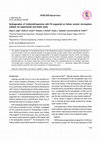
Chemical Engineering Department, Vidyasagar National Institute of Technology Nagpur, Nagpur-440 0... more Chemical Engineering Department, Vidyasagar National Institute of Technology Nagpur, Nagpur-440 010,<br> Maharashtra, India<br> Department of Chemical Engineering, Institute of Chemical Technology, Mumbai-40019, India<br> E-mail: ab.pandit@ictmumbai.edu.in<br> Manuscript received online 10 April 2020, accepted 08 June 2020 The catalytic hydrogenation of 2-ethylanthraquinone in the anthraquinone process of production of hydrogen peroxide gaining<br> more interest to meet environmental demands of hydrogen peroxide as green oxidant. Noble metal palladium becomes a<br> new category of catalyst due to their significant applicability in the catalytic hydrogenation reactions. Herein, wet impregnation<br> method was used for synthesis of palladium supported on hollow ceramic microsphere catalysts. The palladium supported<br> on hollow ceramic microsphere exhibits high catalytic selectivity, activity and stability in the liquid phase hydrogenat...
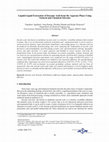
Journal of Applied Science & Process Engineering
Itaconic acid, also known as methylene succinic acid, is a colorless, crystalline substance that ... more Itaconic acid, also known as methylene succinic acid, is a colorless, crystalline substance that is found in nature. Due to its two functional carboxylic acid forms and - unsaturated bond, it can be used in a variety of sectors (plastics, super-absorbents, biopolymers, anti-scaling agents, etc.). Itaconic acid can be produced via thermally decarboxylating citric acid, catalysing the condensation of succinic acid derivatives with formaldehyde, decarboxylating aconitic acid, and fermentation utilizing Aspergillus terreus and other microbes. It is quite expensive and harmful to extract itaconic acid from the fermentation broth. In the present study, Iso-butanol, iso-octanol, groundnut, soybean, mustard, and rice bran oil were incorporated as solvents for separating itaconic acid from their solutions in distilled water. Liquid-liquid extraction experiments were conducted over the range of 0.08-0.533 mol.L-1 of itaconic acid. The results thus obtained were defined as the separation effic...
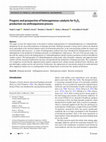
Environmental Science and Pollution Research
This paper reviews the improvement in the field of catalytic hydrogenation of 2-ethylanthraquinon... more This paper reviews the improvement in the field of catalytic hydrogenation of 2-ethylanthraquinone to 2-ethylanthrahydroquinone for the successful production of hydrogen peroxide. Hydrogen peroxide is being used in almost all industrial areas, particularly in the chemical industry and in environmental protection, as the most promising oxidant for cleaner and environmentally safer processes. A variety of hydrogenation catalysts have been introduced for hydrogenation of 2-ethylanthraquinone in the production of hydrogen peroxide via anthraquinone (AQ) process. The aim of the present study is to describe the catalysts used in the hydrogenation of 2-ethylanthraquinone and the reaction mechanism involved with different catalytic systems. The hydrogenation of 2-ethylanthraquinone using metals, alloy, bimetallic composite, and supported metal catalyst with the structural modifications has been incorporated for the production of hydrogen peroxide. The comprehensive comparison reveals that the supported metal catalysts required lesser catalyst amount, produced lower AQ decay, and provided higher catalyst activity and selectivity. Furthermore, the replacement of conventional catalysts by metal and metal alloy-supported catalyst rises as a hydrogenation trend, enhancing by several times the catalytic performance.
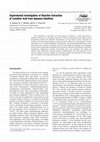
Chemical and Biochemical Engineering Quarterly, 2022
The separation of levulinic acid from aqueous solutions is costly and non-ecofriendly in many cas... more The separation of levulinic acid from aqueous solutions is costly and non-ecofriendly in many cases. The major concerns are the low concentration of levulinic acid in fermentation broths and industrial downstreams. In this study, reactive extraction of levulinic acid from aqueous phase is proposed and its efficacy was investigated. Various extractants viz. tri-n-butyl phosphate, trioctylamine, and trioctylmethylammonium chloride along with i-octanol as a diluent were used. The extent of separation was investigated and various performance parameters like extraction efficiency, distribution coefficient, equilibrium complexation constant, and loading ratio were estimated. The number of transfer units, diffusivity, and mass transfer considerations were also discussed in the reactive separation system. Finally, the conceptual method was provided for the separation of levulinic acid using efficient reactive separation.
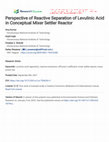
Many industries are using directly biomass as a raw material for the production of valuable bioch... more Many industries are using directly biomass as a raw material for the production of valuable biochemicals. These are used different toxic chemicals such as sulphuric acid, hydrochloric acid, nitric acid, etc. as a catalyst during the production of biochemicals and exit downstream waste material and create environmental pollution. Therefore, downstream waste material separation is important for decrease environmental pollution. Levulinic acid is a carboxylic acid which can be present downstream of industrial waste. It is a very important chemical and can be transformed into different important chemicals such as 1–4 pentanediol, aminolevulinic acid, succinic acid, gamma valarolactone, hydoxyvaleric acid, diphenolic acid, etc. It is considered in the top ten important and bio-derived acids. Levulinic acid can be directly produced from biomass through chemical synthesis and fermentation processes at industrial and lab scales. The synthesis process produces the char whereas the fermentati...
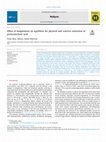
Heliyon, 2020
Owing to its biological and chemical applications, the separation of protocatechuic acid, a polyp... more Owing to its biological and chemical applications, the separation of protocatechuic acid, a polyphenol compound, is of interest to researchers. Extraction studies with initial acid concentration (0.001-0.01 kmol m À3) using aminic extractant tri-n-octyl amine (TOA) (0.2287 kmol m À3-1.1436 kmol m À3) in diluent octanol at diverse temperature ranges from 288 K-313 K was done. Parameters like loading ratio, distribution coefficient, equilibrium complexation constant, diffusion coefficient, number of stages necessary for protocatechuic acid counter-current extraction were obtained; this information is useful in designing a process for the in situ separation of the acid from the fermentation broth as well as from the waste streams. The increase in temperature distribution coefficient was found to increase up to the temperature of 303 K and was found to decrease with a further rise in temperature. The entropy and enthalpy values for the reaction at different temperatures were obtained. The highest extraction of 91.1 % and distribution coefficient of 1.14 were obtained at 313 K for an acid concentration of 0.01 kmol m À3, and TOA concentration of 1.1436 kmol m À3 and 4 stages are required for counter-current extraction process for acquiring the required separation efficiency. Development of 1:1 complex of protocatechuic acid and TOA take place as concluded from the values of the loading ratio.
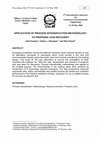
The International Conference on Chemical and Environmental Engineering, 2008
Increasing competition among the different industries made chemical industry to look for alternat... more Increasing competition among the different industries made chemical industry to look for alternative processes or techniques which could provide a low cost and environmentally friendly production which have had not been provided by the existing setups. This could be the only alternative to survive the competition of other industries like software etc. With this view, fermentation and recovery of propionic acid was taken for discussion. Process intensification methodology was applied to the existing process. The shortcomings in the existing setup were removed by introduction of PI technology (reactive extraction). The high productivity, improved propionate yield, highly concentrated and purified product and stable and consistent performance of the reactive extraction process, proposed it to as a suitable process for recovery of propionic acid.
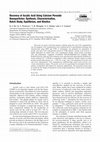
Chemical and Biochemical Engineering Quarterly, 2018
Recovery of acrylic acid from aqueous solution using low-cost CaO 2 nanoparticles was investigate... more Recovery of acrylic acid from aqueous solution using low-cost CaO 2 nanoparticles was investigated. CaO 2 nanoparticles were synthesized by co-precipitation technique and characterised using XRD and FTIR. A mechanism was proposed for adsorption of acrylic acid onto CaO 2 nanoparticles based on FTIR analysis. Acrylic acid recovery is highly dependent on contact time, CaO 2 nanoparticle dosage, initial acrylic concentration, and temperature. Langmuir, Freundlich, Dubinin-Radushkevich, Tempkin, Hill, Redlich-Peterson, Sips and Toth isotherms were used and well represented by Redlich-Peterson isotherm (R 2 = 0.9998) as compared to other isotherms. Kinetic studies revealed pseudo-second-order kinetics (k 2 = 1.962·10-4 g mg-1 min-1) for adsorption of acrylic acid onto CaO 2 nanoparticles. CaO 2 nanoparticles exhibited high acrylic acid recovery over varied concentration ranges. The acrylic acid can be regenerated by desorption from the surface of adsorbent and utilised for numerous applications. The presented results may be useful for the design of adsorption system using nanoparticles, which can be extended to other systems.
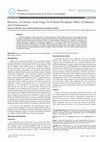
Journal of Chemical Engineering & Process Technology, 2017
Reactive separation of glutaric acid with tri-n-butyl phosphate in ethyl acetate and hexanol was ... more Reactive separation of glutaric acid with tri-n-butyl phosphate in ethyl acetate and hexanol was studied to explain the effect of temperature on the extraction. Extraction was carried out at different temperature range of 308-338 K. The reactive extraction results were discussed in terms of overall distribution coefficients (K D), degree of extraction (η%), loading ratio (φ), and equilibrium complexation constants (K E). The results showed that an increase in temperature reduced distribution coefficients and extraction efficiency for both diluent used in the organic phase. Moreover, thermodynamic function viz enthalpy (∆H), entropy (∆S) and Gibbs free energy (∆G) were calculated. Reactive extraction of glutaric acid by tri-n-butyl phosphate resulted in negative values of enthalpy. Thus, the reactive extraction process is an exothermic reaction.
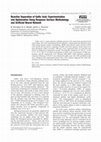
Chemical and Biochemical Engineering Quarterly, 2017
Gallic acid is a major phenolic pollutant present in the wastewater generated from cork boiling, ... more Gallic acid is a major phenolic pollutant present in the wastewater generated from cork boiling, olive mill, and pharmaceutical industries. Experimental and statistical modelling using response surface methodology (RSM) and artificial neural network (ANN) were carried out for reactive separation of gallic acid from aqueous stream using tri-nbutyl phosphate (TBP) in hexanol. TBP has a more significant effect on extraction efficiency as compared to temperature and pH. The optimum conditions of 2.34 g L-1 , 65.65 % v/v, 19 o C, and 1.8 of initial concentration of gallic acid, concentration of TBP, temperature, and pH, respectively, were obtained using RSM. Under optimum conditions, extraction efficiency of 99.45 % was obtained for gallic acid. The ANN and RSM results were compared with experimental unseen data. Error analysis suggested the better performance of ANN for extraction efficiency predictions.
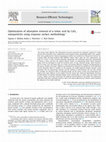
Resource-Efficient Technologies, 2017
The present work addresses the optimization of process parameters for adsorptive removal of α-tol... more The present work addresses the optimization of process parameters for adsorptive removal of α-toluic acid by calcium peroxide (CaO 2) nanoparticles using response surface methodology (RSM). CaO 2 nanoparticles were synthesized by chemical precipitation method and confirmed by Transmission electron microscopy (TEM) and high-resolution TEM (HRTEM) analysis which shows the CaO 2 nanoparticles size range of 5-15 nm. A series of batch adsorption experiments were performed using CaO 2 nanoparticles to remove α-toluic acid from the aqueous solution. Further, an experimental based central composite design (CCD) was developed to study the interactive effect of CaO 2 adsorbent dosage, initial concentration of α-toluic acid, and contact time on α-toluic acid removal efficiency (response) and optimization of the process. Analysis of variance (ANOVA) was performed to determine the significance of the individual and the interactive effects of variables on the response. The model predicted response showed a good agreement with the experimental response, and the coefficient of determination, (R 2) was 0.92. Among the variables, the interactive effect of adsorbent dosage and the initial α-toluic acid concentration was found to have more influence on the response than the contact time. Numerical optimization of process by RSM showed the optimal adsorbent dosage, initial concentration of α-toluic acid, and contact time as 0.03 g, 7.06 g/L, and 34 min respectively. The predicted removal efficiency was 99.50%. The experiments performed under these conditions showed α-toluic acid removal efficiency up to 98.05%, which confirmed the adequacy of the model prediction.
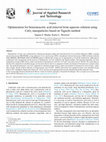
Journal of Applied Research and Technology, 2017
Nanoparticles of CaO 2 were synthesized by chemical precipitation method and characterized by X-r... more Nanoparticles of CaO 2 were synthesized by chemical precipitation method and characterized by X-ray powder diffraction (XRD), scanning electron microscope (HR-FESEM), energy-dispersive X-ray spectroscopy (EDX), transmittance electron microscopy (TEM) and high-resolution TEM (HRTEM). HR-FESEM, TEM, and HRTEM images confirmed the average size of nanoparticles as 10-40 nm. Furthermore, application of synthesized CaO 2 nanoparticles for the removal of benzeneacetic acid was studied by the Taguchi method. The operating parameters are CaO 2 nanoparticles dosage (0.008-0.03 g), initial concentration of benzeneacetic acid (6.8-13.47 g/L), and contact time (5-60 min). The result indicates that the CaO 2 nanoparticles adsorbent dosage was the most effective factors as compared to initial concentration of benzeneacetic acid and contact time. The optimum parameters were CaO 2 nanoparticles adsorbent dosage = 0.03 g, initial concentration of benzeneacetic acid = 6.8 g/L, contact time = 30 min, and the removal efficiency of benzeneacetic acid = 94.49%. ANOVA showed the most significant factors were adsorbent dosage with 93.78% contribution. Regression analysis (R 2 = 0.91) showed a good agreement between the experimental and the predicted values.

Resource-Efficient Technologies, 2017
Pervaporation is a membrane separation process vastly used for purification in chemical and allie... more Pervaporation is a membrane separation process vastly used for purification in chemical and allied industries. Esterification reaction can be intensified and enhanced by coupling with pervaporation reactor (PVR). Polyvinyl alcohol (PVA)/polyethersulfone (PES) composite membrane was used for the pervaporation coupled esterification reaction study. Esterification of butyric acid with n-propanol was taken as a model reaction for the study and to test the performance of pervaporation reactor. Catalyst p-toluenesulfonic acid was used for the esterification reaction. The effects of various reaction parameters on conversion of butyric acid such as reaction temperature, initial molar ratio of n-propanol to butyric acid, catalyst loading and reaction time were studied. Experimental results show that the increase of temperature, initial molar ratio, and catalyst concentration enhance the conversion of butyric acid considerably. The highest conversion of 96.41% was obtained at temperature 353 K, molar ratio of 2 and catalyst loading of 2.5%w/w at reaction time of 420 minutes. PVA/PES membrane used in the experiments shows the good activity and hydrophilicity and plays a vital role for enhancing the conversion by selectively removing water. Pervaporation coupled esterification shows the better choice over the conventional route for the production of esters. This technique is environment friendly and energy intensified approach as it reduces pollution and energy requirement.
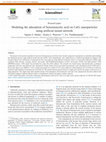
Resource-Efficient Technologies, 2016
The present work reported a method for removal of benzeneacetic acid from water solution using Ca... more The present work reported a method for removal of benzeneacetic acid from water solution using CaO2 nanoparticle as adsorbent and modeling the adsorption process using artificial neural network (ANN). CaO2 nanoparticles were synthesized by a chemical precipitation technique. The characterization and confirmation of nanoparticles have been done by using different techniques such as X-ray powder diffraction (XRD), high resolution field emission scanning electron microscope (HR-FESEM),transmittance electron microscopy (TEM) and high-resolution TEM (HRTEM) analysis. ANN model was developed by using elite-ANN software. The network was trained using experimental data at optimum temperature and time with different CaO2 nanoparticle dosage (0.002-0.05 g) and initial benzeneacetic acid concentration (0.03-0.099 mol/L). Root mean square error (RMS) of 3.432, average percentage error (APE) of 5.813 and coefficient of determination (R 2) of 0.989 were found for prediction and modeling of benzeneacetic acid removal. The trained artificial neural network is employed to predict the output of the given set of input parameters. The single-stage batch adsorber design of the adsorption of benzeneacetic acid onto CaO2 nanoparticles has been studied with well fitted Langmuir isotherm equation which is homogeneous and has monolayer sorption capacity.
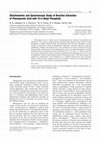
Chemical and Biochemical Engineering Quarterly, 2015
Phenylacetic acid is widely used in the pharmaceutical industry for production of antibiotics. Th... more Phenylacetic acid is widely used in the pharmaceutical industry for production of antibiotics. The recovery of phenylacetic acid from dilute aqueous waste with tri-n-butyl phosphate in methyl isobutyl ketone and petroleum ether has been attempted, and the results are presented in terms of distribution coefficient, extraction efficiency, apparent equilibrium constant, and loading ratio. The mechanism of reactive extraction was analyzed and the stoichiometric ratio of phenylacetic acid to tri-n-butyl phosphate in methyl isobutyl ketone and petroleum ether was found to be 1:0.5 and 1:1.2. Mass action law was used to represent the reactive extraction equilibrium for phenylacetic acid−tri-n-butyl phosphate−diluents which satisfied much in the present study. FTIR spectroscopy was studied for confirmation of the formation of a complex between acid and extractant. Further relative basicity approach has been extended to represent the experimental results. The model is best suited to experimental results.
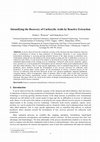
It can be observed from the worldwide economy of the chemical and allied industries, there has be... more It can be observed from the worldwide economy of the chemical and allied industries, there has been a revitalization of interest in large production of fermentation chemicals. A new energy-efficient fermentation technology is receiving growing attention because of the sharp increase in petroleum costs. Fermentation chemicals are still limited in the current market in large part due to difficulties in recovery of carboxylic acids. Hence, it is the need of the industry to develop the new energy efficient recovery process or substantial improvements in the existing recovery technology. Carboxylic acids (Lactic, propionic, caproic, lactic, picolinic etc.) can be produced by fermentation and are chemicals widely used in pharmaceutical, food and other allied industries. Due to some specific applications such as controlled drug delivery or artificial prostheses, draws attention towards the development of new recovery processes for carboxylic acids production. In present paper various aspects for the development of reactive extraction process for the recovery of carboxylic acids has been discussed. In this view, physical equilibrium, chemical equilibrium, extraction kinetics, effect of temperature, effect of substrate, effect of salts, effect of pH, back extraction equilibrium and kinetics, regeneration, toxicity, water co-extraction, economical has been analyzed and presented. This paper will be very useful in the context of design of intensifying process for the recovery of carboxylic acid by reactive extraction.
Industrial & Engineering Chemistry Research, 2014
Department of the teacher Name of journal Year of publication ISBN/ISSN number Link of the recogn... more Department of the teacher Name of journal Year of publication ISBN/ISSN number Link of the recognition in UGC enlistment of the Journal Anti-arthritic and antiinflammatory activity of combined pioglitazone and prednisolone on adjuvantinduced arthritis.
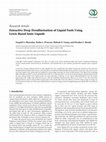
Journal of Energy, 2013
A new class of green solvents, known as ionic liquids (ILs), has recently been the subject of int... more A new class of green solvents, known as ionic liquids (ILs), has recently been the subject of intensive research on the extractive desulfurization of liquid fuels because of the limitation of traditional hydrodesulfurization method. In present work, eleven Lewis acid ionic liquids were synthesized and employed as promising extractants for deep desulfurization of the liquid fuel containing dibenzothiophene (DBT) to test the desulfurization efficiency. [Bmim]Cl/FeCl3was the most promising ionic liquid and performed the best among studied ionic liquids under the same operating conditions. It can remove dibenzothiophene from the model liquid fuel in the single-stage extraction process with the maximum desulfurization efficiency of 75.6%. It was also found that [Bmim]Cl/FeCl3may be reused without regeneration with considerable extraction efficiency of 47.3%. Huge saving on energy can be achieved if we make use of this ionic liquids behavior in process design, instead of regenerating ioni...
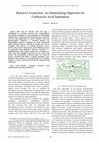
International Journal of Chemical Engineering and Applications, 2012
Since last few decades, there has been a revitalization of attention towards new energy-efficient... more Since last few decades, there has been a revitalization of attention towards new energy-efficient fermentation technology for large production of fermentation chemicals due to sharp increase in petroleum costs. Carboxylic acid has wide applications in various chemical, food, and pharmaceutical industries. A growing demand for biodegradable polymers, substitutes for both conventional plastic materials and new materials of specific uses such as controlled drug delivery or artificial prostheses, draws attention the need for improvement of conventional processes for carboxylic acids production. Reactive extraction is a multifunctional reactor having reaction and extraction in a single unit. This intensified approach has the closed loop process with sustainability. In present paper, the concept of reactive extraction and effect of various parameters were discussed. These studies are very useful in the view of complete design of a reactive extraction process for the carboxylic acid production.
Engineering, 2011
The recovery of caproic acid from the aqueous stream is of practical relevance due to its market ... more The recovery of caproic acid from the aqueous stream is of practical relevance due to its market value and the stringent environmental standards. The profound success of reactive extraction has been noted in the recovery of carboxylic acids from dilute solutions. In present paper, equilibrium of caproic acid with aliquat-336, a quaternary amine compound, in xylene and Methyl Isobutyl Ketone (MIBK) has been studied. Equilibrium parameters such as distribution coefficients, loading ratio, degree of extraction and equilibrium complexation constants have been presented. The data obtained is useful in understanding the equilibrium characteristics and efficient design of the recovery process of caproic acid by reactive extraction.









Uploads
Papers by Dr. Kailas Wasewar